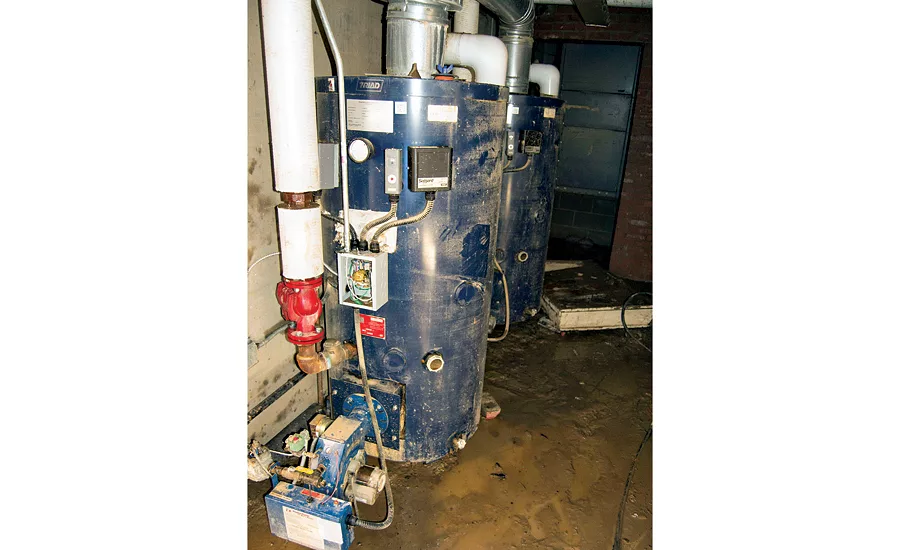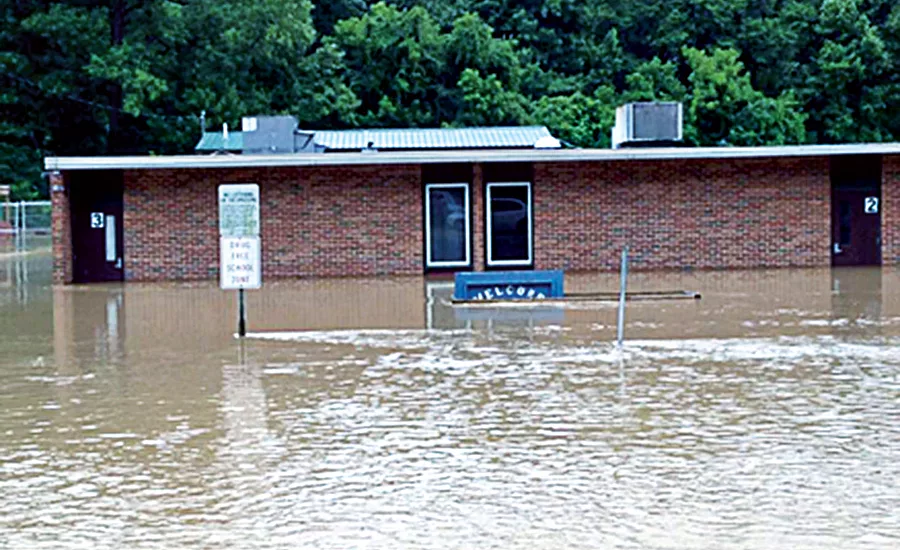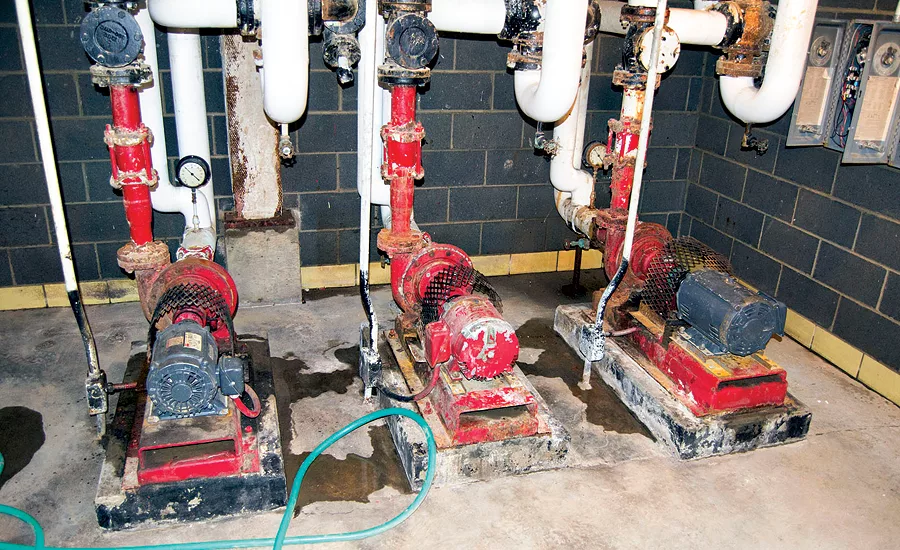The flooded boiler room
Preparing for disaster.

These two boilers are only a few years old. The building owner has to scrap them because they were completely submerged and ruined beyond repair. Photo credit: Ray Wohlfarth

The entrance of one of the flooded schools for Kanawha County — at this point, the water is still several feet deep. Photo credit: Ray Wohlfarth

This is the inside of a burner control panel; notice the mud on the bottom of the panel. The water was several feet higher than that. The burner cannot be used and will require replacement. Photo credit: Ray Wohlfarth

This set of hot water circulating pumps is inside a flooded boiler room. The pumps, wiring and pipe insulation will have to be replaced. Photo credit: Ray Wohlfarth
On June 23, a thunderstorm watch was forecast for much of West Virginia, a common summer occurrence in the state. What the forecasters did not anticipate was a weather phenomenon called “training,” which occurs when a series of thunderstorms line up in succession behind one another in the same location.
At the end of the storms, about 10 in. of rain fell on the area. To appreciate how much rain that is, consider 1 in. of rain equals about 13 in. of snow, according to the National Severe Storms Laboratory, making this storm equivalent to more than 10 ft. of snow.
The total rainfall was considered a once-in-a-thousand-year event, causing massive flash floods throughout the state. The topography of the state with its majestic mountains contributed to the disaster as the rain rolled off the mountains and into the valleys.
The immediate aftermath was intense and devastating. More than 1,200 homes were destroyed and 26 people lost their lives. Many businesses were ruined. Jim Justice, owner of the Greenbrier Resort, said in a radio interview that the fatality rate in his county could have been much worse if the flash flood happened at night rather than late in the afternoon.
The summer was like any other for Terry Hollandsworth, executive director of maintenance for the Kanawha County School District. He was on a tight schedule to get his buildings ready for the start of the school year, a little more than a month away. On June 23, everything changed.
Starting the day with a 2 a.m. call from the school superintendent informing him of flooding in a nearby town to ending it with the realization four schools and a bus garage sustained massive damage. One of the other schools had to be converted to emergency housing for the area residents displaced by the flood. Many of the affected areas were without power, cable TV or telephone service. Among the displaced citizens living inside the school gymnasium was one of Hollandsworth’s employees, forced from his home by the flood.
FEMA closes schools
Two of the schools were so severely damaged that Federal Emergency Management Agency declared the buildings a total loss. The school district had to find somewhere else to send the several hundred students. FEMA handed down this decision to the district on July 21, just 18 days from the start of the school year. Where do you find a school sized for several hundred students in a little over two weeks?
The students from the flooded schools were sent to other schools on a staggered schedule with both sharing the building for a half day each. To complicate matters even further, mold and mildew formed inside the flooded schools within a few days. A mask and gloves were required to enter the schools.
Some items could be salvaged but each item had to be tested for bacteria before being sent to another school. The school maintenance and custodial personnel had to work 12-hour shifts, seven days a week to clean the mess. The school district maintenance department budget took a huge hit with the costs of recovering from the flood.
Michael Pickens, executive director at the Office of School Facilities for West Virginia, was at home when he received the first call at 10 p.m. on June 23. He contacted the West Virginia Division of Homeland Security and Emergency Management, which in turn contacted FEMA. The next day was filled with Pickens and his staff contacting the school districts affected by the flooding to assess the damage, which was severe and extensive. During the initial assessment by Pickens’ office, 25 schools in the state were affected by the floods and some have damage so severe, they are permanently shuttered. After two weeks of assessment, the number of flood-damaged schools rose to 33.
FEMA requires buildings with damage greater than 50% of the building’s value to be brought up to the current codes, which was impossible for some of the schools. FEMA will pay for only a percentage of the repairs or building value and the owner is responsible for the remaining amount due.
The damage to Herbert Hoover High School for Kanawha County Schools was about 70% of the building’s $25 million value. Clendenin Elementary sustained damages totaling over 97% of the school’s $3.7 million value. In addition, the replacement schools cannot be constructed on the same land, or the school must be raised above the flood level before it qualifies for FEMA funding. In many cases, new land has to be purchased.
Preparing for a disaster
My company, Fire & Ice Heating & Cooling, was asked to evaluate the condition of the flooded boilers in the district. My son Jon Wohlfarth and I visited three of the schools in Kanawha County on June 30.
We had seen pictures and videos of the devastation but nothing prepared us for what we experienced. The damage was far worse than we imagined. Stacked in front of the homes were tall mounds of wet clothes, photographs and personal belongings, waiting to be thrown into a landfill. Mountains of these personal belongings were piled high in shopping center parking lots. We saw abandoned vehicles covered with mud on every street. A terrible smell permeated the air.
When we visited one of the schools, officials warned us to be careful as copperhead snakes displaced from the storm were inside the school. I chose to skip that boiler room.
We saw a maintenance department crew in one school trying to salvage the kitchen equipment. The water level in Herbert Hoover High School rose to 7 ft. while the basement in Clendenin Elementary was completely submerged. Inside the boiler room, the floor and all the equipment were filled with mud. The covers were removed from the electrical panels and large industrial fans were directed at the equipment to dry the components. The boilers, which were only a few years old, were ruined.
One of the questions I had was, “How do you know what can be repaired and what has to be discarded?” Pickens says the schools have Indoor Environmental Guidelines and FEMA can provide assistance.
Hollandsworth says a rule of thumb is anything in which the flood water could have entered has to be discarded; the health of the employees has to be considered during the cleanup as the sludge from the flood could contain dangerous chemicals and harmful bacteria. Millions of dollars of pumps, boilers, water heaters, kitchen equipment, smart boards in the classrooms, televisions and computers were destroyed.
Pickens offers advice to limit the damage from flash flooding: Build outside of the 100-year flood plain and carry flood insurance. If the flood waters start to rise, instruct employees to move materials and equipment from lower levels to safe and dry parts of the building.
Hollandsworth suggests the following steps for dealing with a flooded building:
-
Be prepared for lots of hard work. The mud, water and sludge get into everything.
-
Make sure your flood insurance reflects the current value of the building or house.
While you may not be able to prepare for every catastrophe, you could plan how to mobilize and respond. Kanawha County Schools were able to open the two flooded schools only three days past the scheduled first day of school, a herculean task for an exhausted maintenance staff.
If you or your customer has flooding inside a building, follow the equipment manufacturer’s guidelines and remember Hollandsworth’s advice, “If water can get inside, you most likely have to dispose of it.” This includes wiring, electrical outlets, conduit, insulation, fuel piping, refractory, gas train components, switches, contactors, motors and pumps.
Boiler manufacturer Weil-McLain, issued this warning: “Weil-McLain equipment contaminated with saltwater or polluted water will no longer be covered under warranty and should be replaced.”
U.S. Boiler suggests when its boilers have been in a flood: “Do not operate your boiler if any components have been fully or partially submerged in water until the boiler has been inspected and all affected components or the boiler are replaced by a qualified heating contractor.”
The weird thing about flooding is the damage may not be evident right away. We serviced the boilers in a local hospital and the building had a 14-in. water line break, filling the boiler room with about 7 ft. of water. We suggested the hospital replace the burner, gas train and all controls. Instead, the hospital chose to dry the components and reuse them. The damage appeared a few months later when one of the gas valves rusted open. Luckily, the second valve held or this could have been a disaster.
Use caution when going inside a flooded boiler room. Make certain all power is turned off to the boiler room before entering after a flood. The people of West Virginia will overcome this disaster but the emotional and economic costs will be with them for many years. When I feel like complaining about something that happens to me, I think about the survivors of these types of catastrophes and realize how lucky I am.
Looking for a reprint of this article?
From high-res PDFs to custom plaques, order your copy today!




